In the garden, if no where else, this spring has been normal: irises, columbines, and poppies set forth their early blooms exactly on time. As the days lengthened and temperatures warmed, coneflowers, salvia species, and sunflowers flowered-up, right on cue. Bees, butterflies, and birds are out-and-about doing their things: mating, nesting, seed-eating and pollinating.
What has been weird and also wonderful (or mostly so) are appearances by a variety of reptiles that I rarely, if ever, see in my garden. I’ve enjoyed a quick look from a Texas Spiny Lizard, never before seen in my garden, and visits by two different Texas Rat Snakes, a large adult and a small young one. It’s not odd to see one rat snake from time-to-time, but several look-sees within a couple of weeks is a special treat.
My most recent reptile encounter was with this critter, a Common Snapping Turtle.
I was gazing out a window early one the morning, trying to recall what day it was, coffee cup in hand, when I saw plants waving in the wind at the border of a path. From the greenery emerged a turtle, bumbling onto the pathway. By the time I approached the turtle, it had stopped its lumbering, no doubt because it sensed a larger predator nearby. I’m confident this is a Common Snapping Turtle, Chelydra serpentina, because its geographic range is wide and includes Austin. Another turtle species, the Alligator Snapping Turtle, Macrochelys temminckii, is threatened, living in a limited range, primarily in East Texas. Also, Common Snapping Turtles, while spending time in water, are also found in brush, whereas Alligator Snapping Turtles are mostly aquatic creatures, on the ground less often.
I think this turtle is relatively young, as snapping turtles can grow quite large
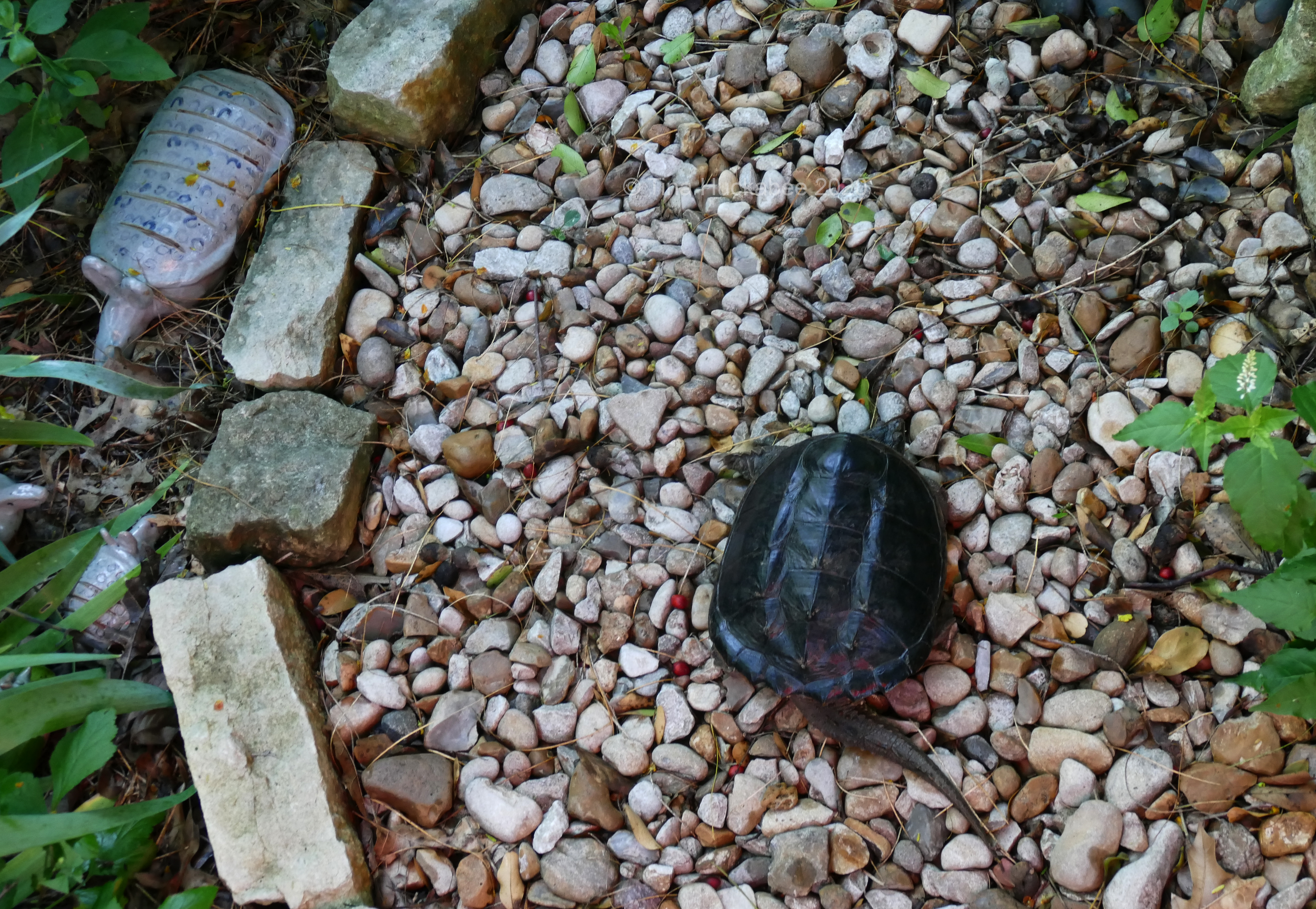
I like this shot: live snapping turtle headed one way on the path, ceramic armadillo (with accompanying ceramic babies) headed in the opposite direction.
Astrud the Cat was enjoying her morning garden stroll and padded over for a look.
She wasn’t quite sure what to make of this new garden creature.
Animal, vegetable, or mineral?
Whatever this thing is, I’m going around it–who knows what it’s up to?!
Well, the turtle had been up to something and that became clear over the next day or so. My pond normally looks like this in May.
After spring pruning and lily re-potting, the lilies send up stems topped by new foliage–lily pads. The foliage spreads out, covering much of the pond’s surface. The foliage protects the fish from the hunting eyes of predators and also helps maintain the average temperature of the water during the upcoming hot months.
The day of the turtle sighting, I noticed that all the lily pads were arranged in a half-moon shape around the edges of the pond, the pads all bunched up, with no social distancing. Had something disturbed their normal pattern? The water was also murkier than normal. Raccoons have sometime mucked around in the water, though no real damaged has ever resulted, other than terrifying the poor little fish. I didn’t think much about either bit of evidence until the next morning, when I observed that of the lily pads remaining, most were upended. The pads had clearly been chopped off from the base of the plants.
This pad found itself in the bog area, face down, stem up:
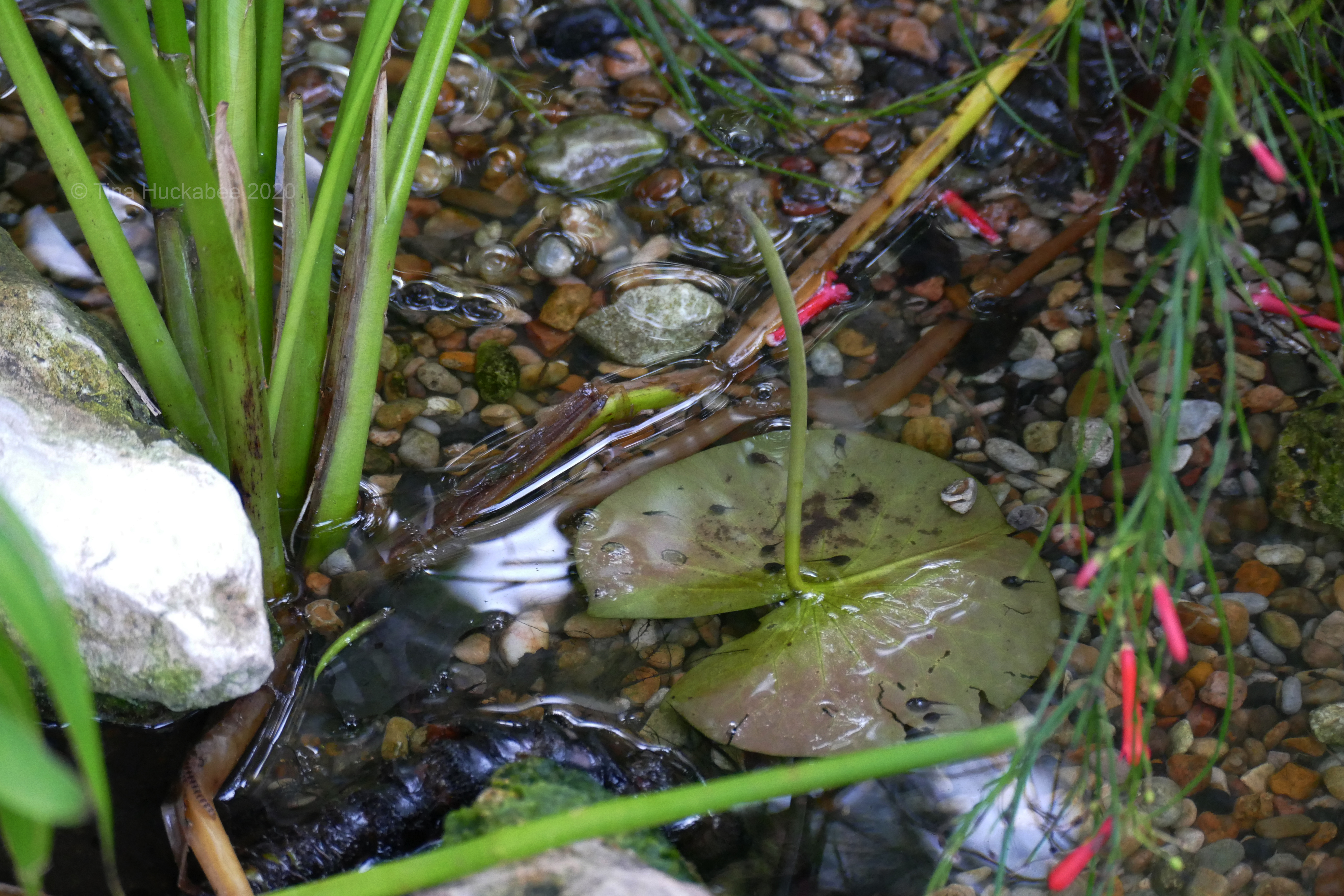
Look at the the lily closely. Do you see the tadpoles swimming in the water covering the bottom of the lily? Toads of the future!
Other lily pads were free-floating on the pond’s surface, untethered from their roots. I fished out the wayward pads and tossed their decapitated heads into the compost bin.
I lugged the lily plants to the surface and they were definitely eaten down, practically to their base. Someone had a lily stem late-night lunch. Or dinner. Or breakfast.
Common Snapping Turtles eat just about anything, including plant matter–and so he/she apparently dined in my pond! I didn’t notice any goldfish missing, but it would be hard to tell if the turtle ate any of the gambusia (mosquito fish), as they’re small and too numerous to count. The turtle definitely ate greens and its meal might have included a side of protein.
Since the turtle-led lily decimation, the pond’s water has been cloudier than is typical, in part because the lilies, along with the bog plant, Pickerel Weed, help filter the water, keeping it clear. Interestingly, the turtle didn’t bother the stems of the Pickerel Weed, which is a bog plant; they remain intact and unmolested.
The not-so-wonderful part of a snapping turtle in the garden is that the pond is lacking in lilies, it is nearly lily-less, and has resigned its moniker as lily pond–for now. 
The lily plants should recover and probably quickly; I’ve already spotted some new stems, stretching upwards, making their way to the surface.
Will the turtle come back for more pond salad? I would prefer it move elsewhere, but my garden is open to wildlife. Sometimes, toleration of wildlife wildness is part of a wildlife gardener’s commitment to critter survival.
For more information about snapping turtles, check out this short, educational video illustrating the differences between the Alligator and Common Snapping Turtles. Watch your fingers!
We live in wild times, that’s for certain. But the good kind of wild occurs in the garden, with the occasional munched plant(s) served up as sacrifices. I hope your garden hosts both captivating critters and pleasing plants. As well as being Wildlife Wednesday, I’m also joining with Anna and Wednesday Vignette. Please post about your wild garden happenings and then pop over to Flutter and Hum for vignettes, garden and otherwise. Happy wildlife gardening!




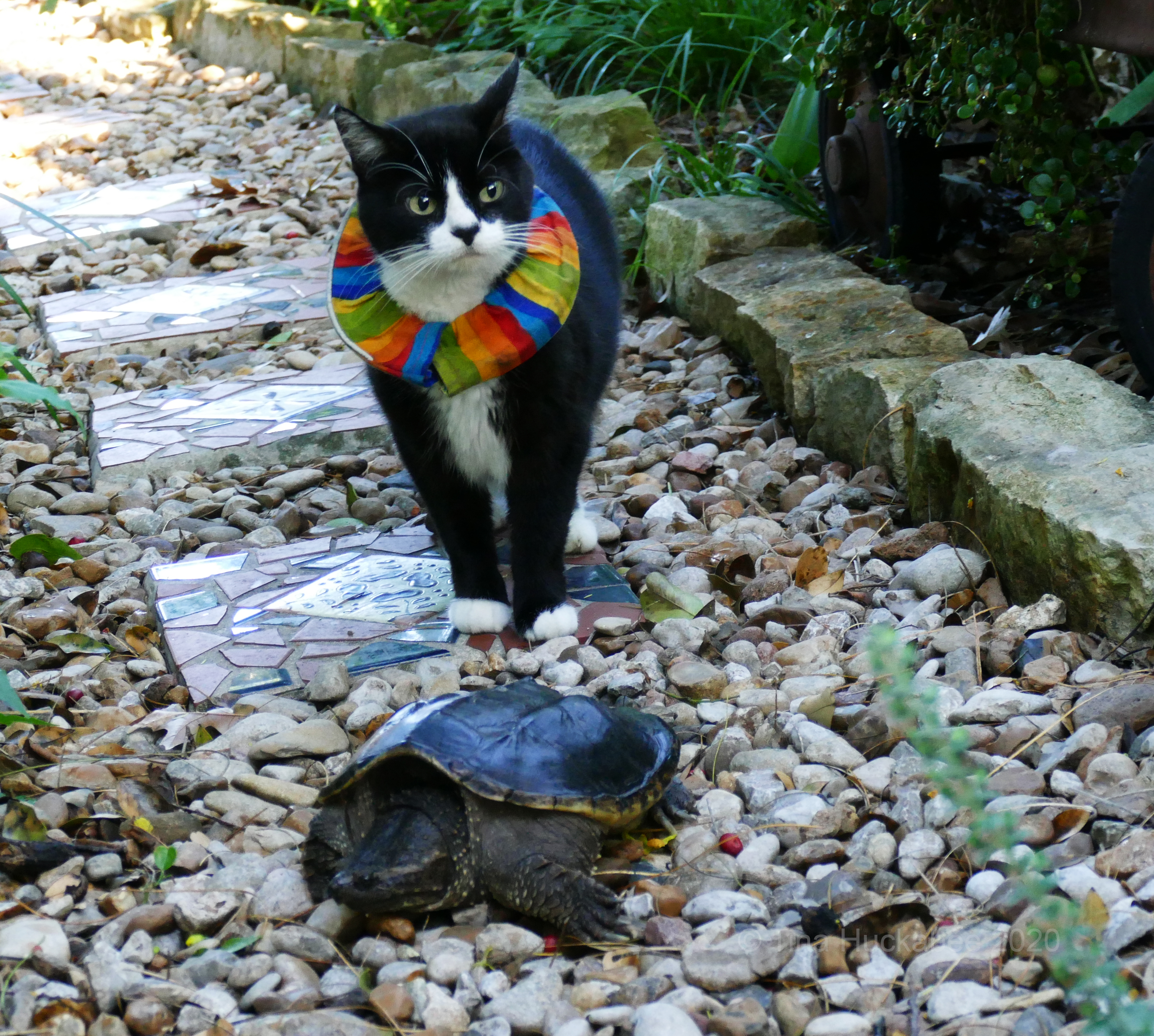


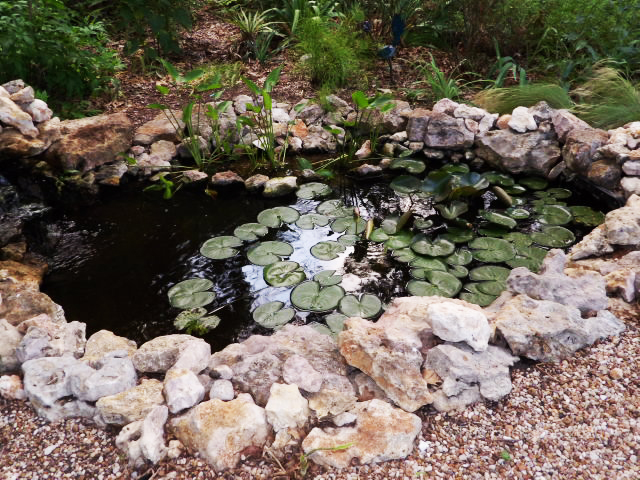
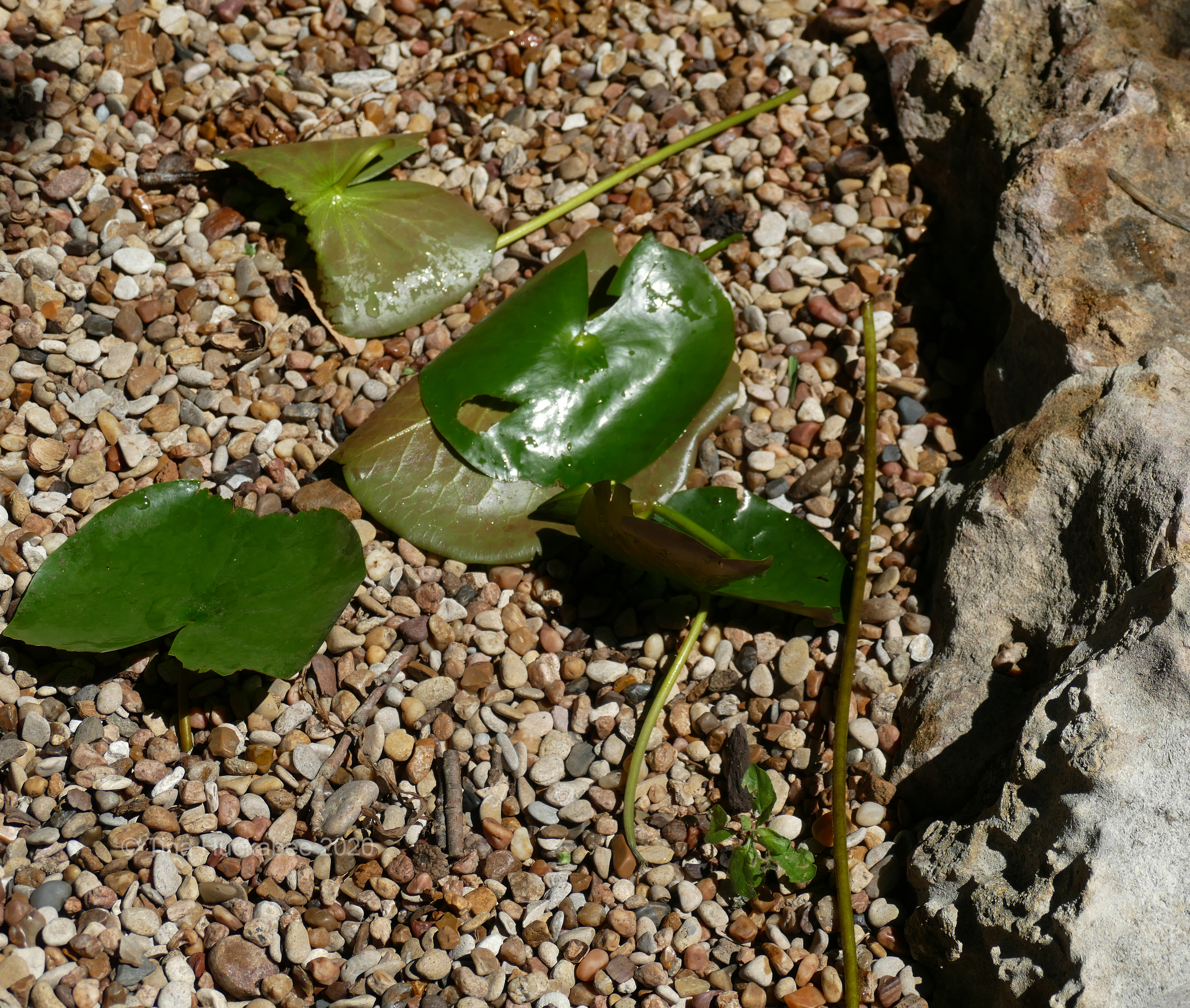

Wow, a snapping turtle. Are there any larger bodies of water near you? Do you think the turtle had to cross streets to get to your pond? I know the Red Sliders from the lake that show up in my yard, have to go under fences and cross a street that can be busy at times.
LikeLike
Judy, I don’t live too far from the northern point of Shoal Creek (half mile-ish) and I have seen the occasional squished turtle in the roads. Still, he/she would have needed to travel a bit to get to my place. I suppose that it’s possible that the turtle is someone’s pet, though I think that unlikely.
LikeLiked by 1 person
Thanks! Fascinating.
I am also curious about Astrid’s neckwear. Can you describe it?
Thanks.
LikeLike
Hi Jane! Astrud’s collar is a Birds be Safe collar, https://www.birdsbesafe.com/. The theory is that the collar, with its bright colors, makes cats more visible to birds. There is research in support: https://www.theatlantic.com/science/archive/2015/12/accessories-for-your-murderous-pet/419601/
Neither of my cats is outdoor all the time (Astrud, only in the morning and after dark), my older male, is well, older and doesn’t do much more than sleep in his favorite outdoor chair. 🙂 They both wear the collar (it fits over a regular collar with a bell), and they’ve never minded wearing the collars. The collar does seem to help at least as far as birds go, though lizards, etc., aren’t impacted by the colors. For what it’s worth, I still think it’s good to keep cats indoors.
LikeLike
Astrud is adorable in her collar – she is definitely noticeable in the best possible way. So glad your lilies weren’t munched into oblivion! As I was reading I kept thinking that turtle hit your pond the way the deer keep hitting our beds outside the fence. What we see as a visual treat the deer see as a more literal one. Exciting times in the pond!
LikeLike
Astrud is adorable, always. 🙂 Yes, the turtle (and your deer) clearly view our gardens differently than do we.
LikeLike
Had you not seen the turtle, you might not have figured out what happened to the water-lilies. I’ve read that snapping turtles can bite off a finger, so your warning was to the point.
LikeLike
Yep, and even then, I was a little slow on the uptake. I noticed that the day before I saw the turtle (probably after its first foray into the pond overnight) that the fish were skittish. I always attribute that to raccoons dipping their paws into the pond, but this time, it wasn’t a raccoon.
LikeLike
How exciting to have a turtle move in! Well, too bad about the lily pond, but still… Anything out of the ordinary in the garden is always a source of marvel. I hope the turtle comes back but finds a less noticeable source of food.
LikeLike
Yes, it was exciting! I haven’t seen it since and suspect it moved on. As for the lilies, grrr! I checked them just a little while ago; I think the fish have finished the greens! The lilies are alive and trying to send up new shoots, but they are getting nibbled to the nub. I’m going to feed the fish more often over the next few weeks and see if that’ll help the lilies recover. They’re pretty tough plants. I hope. 🙂
LikeLiked by 1 person
Best of luck! Yes, distract them with food. It helps with most of us earthly creatures. LOL!
LikeLike
Pingback: Wildlife Wednesday – Looking after Baby | Frogend dweller's Blog
How fascinating! I always imagine that plants in the pond are safe from large-scale marauding. Sad to see those detached leaves floating free, but the turtle is cool! It will be interesting to see if it becomes a regular.
Here is my wildlife post: https://wp.me/pM8Y1-7PD
LikeLike
Yeah, I agree; I wouldn’t have dreamed of this happening, but it makes sense. These are the kinds of greens turtle would eat in a large, natural pond of body of water.
LikeLike
What a pleasure to enjoy in your garden a Texas spiny lizard and two rat snakes: I love it. I love the common snapping turtle even if it doesn’t behave very well with the pond, and the photos are magnificent. Astrud is gorgeous and charming with her rainbow necklace. She is the same as my cat Pepé who passed away in 2015. Astrid is very good, she continued taking her walk without disturbing the turtle. The cut lily pad next to the lily with water full of tadpoles swimming: the next generation of toads, a catastrophe. The common snapping turtle ate the lilies, smashed the water lilies – they are the risks of having a garden for wildlife. Fortunately, lilies are regrowing. But how long will they last? Tina thank you very much for the instructive and fantastic video of the turtles: I have learned a lot. Tina forgives for not writing before but the heat of 33ºC, which is nothing for Madrid since we arrived in Summer at 40ºC, and the storms with rain and the atmosphere rarefied by storms have aggravated my depression and I have had a headache. Keep you and your husband safe. Happy Gardening of Wild Life !! Very affectionate greetings from Margarita
LikeLike
I’m glad you enjoyed the post, Margarita. I also hope the lilies will recover; the fish are now nibbling on the green stems, preventing them from growing to the surface of the pond. Oh, well. It’s a garden, it will be fine. Sending good thoughts to you and your mother and hope you’re well.
LikeLiked by 1 person
Thank you very much Tina for your words. My mother and I are fine. I hope the minnows stop nibbling on the lily stems so they can grow out of the water. I hope that you and your husband are also well. Very affectionate greetings from Margarita.
LikeLiked by 1 person
I’ve never seen a turtle with a long tail before, how strange! We don’t have snapping turtles in the UK, but have Terrapins that can be quite vicious (even when they’re little they’ll try to take off your finger). I’m fascinated by that video though do wish the poor creatures could have been put back in the water. The way they had their mouths open reminds me of the defensive beak-open posture of sunbathing birds.
LikeLike
It really was a long tail, I agree. I’m not particularly knowledgeable about turtles, but know that snappers are around here. I’m sure that the guys didn’t keep the turtles out of water too long. They have several videos with information about other critters, so I think they’re respectful. But the turtles were stressed, to be sure.
LikeLiked by 1 person
In most turtles, the longer tail belongs to the male; it’s thicker, too. Given the size of this one’s tail, I’d say you have a boy turtle roaming your pond.
LikeLike
Oh, that’s interesting! I’m assuming this one is not a mature turtle, just based on what I read about their mature size. At first, I thought it might be an alligator snapping turtle, but I doubt it now, just because of the range. That said, apparently some folk have them (alligator and common) snapping turtles as pets and it might have been release, or somehow got away.
LikeLike
Your pond looks great! I can see why the critters like your property. How wonderful to have so many visitors that you don’t usually see!
LikeLike
Thanks, Beth. It has be fun this year, seeing these critters that aren’t the norm.
LikeLike
Hello Tina,
I love Astrud’s colourful collar and if it helps keep the birds safe even better. I’ve never heard of snapping turtles before, I have always thought of turtles as more gentle creatures, how wrong was I! interesting to see and learn about them, shame about the water lilies though I hope they pull through, to stop the fish eating the new growth could you put the lilies in a container without predators until the first leaves get a bit larger, just to give them more of a chance.
I have seen a lot more of the Red deer this year and had one in my garden early this morning, I’ve post and linked to your lovely wildlife meme:
thanks for creating and hosting this meme, Frances
LikeLike
Thanks, Frances! So nice to “see” you! Yes, turtles are predators, so they hunt and eat. I did exactly what you’re suggesting yesterday evening: the lilies are now sitting in water, in a large, un-used ice chest, in my front garden (gets more sun). I’ll leave them in their temporary home until they’ve both sprouted up plenty of stems and pads, then put them back into the pond. Fingers-crossed that this works.
LikeLiked by 1 person
You may have solved a mystery for me. I wasn’t totally happy with my photo of the yellow water lily that I recently posted, so I made a trip back to the pond to see if I could do better. When I got there, I was astonished to see the nearly had disappeared, and many of the pads were flipped or torn up It seemed clear that ‘something’ had happened, but I didn’t know what. Now I’m wondering whether turtles were responsible. At the Brazoria refuge, it’s entirely likely. The question is, do all turtles munch on that greenery? I’ve seen plenty of red sliders there, but no snapping turtles.
LikeLike
I think these turtles are cagey in their movements. I also wonder if it’s breeding season, so maybe they’re out and eating more? That’s true of so many other critters, wouldn’t it be true of turtles, too?
LikeLike
I’d think so. And even though some time has passed since they emerged from the mud, they still might have a bit of an appetite.
LikeLiked by 1 person
love it! And the turtle video was great. I am in Cedar Creek and we have had a snapping turtle show up twice trying to get to the next door neighbor’s pond via the fence. We helped it under the fence with a shovel, but boy was it mad! They do this cool puff up and hiss thing that is scary!!!
LikeLike
Glad you enjoyed the turtle story and the video, Janet. That’s an interesting story of your own! I’ll be the hissing and turtle tantrum was scary–those claws, that hooky mouth thing! Anyhow, I hope your turtle found its way to the pond–so it can eat someone else’s lilies!!
LikeLike
Great video. I’ve always been kind of scared of these critters.
LikeLike
I know what you mean: those claws, that beak, that gnarly skin! This one was a placid fella, though.
LikeLiked by 1 person
The info and pictures of the turtles are great. The last couple of days, we have had a box turtle going back and forth across our road. Thankfully it is a road less traveled. I guess it cannot decide which side on the street to live on. Thanks again for the post.
LikeLike
Thanks–and you’re welcome, Geri! I’m glad your box turtle is safe crossing your road–they don’t move too fast, after all!
LikeLiked by 1 person
One of these I am going to follow it to see why it keeps doing it.
LikeLike